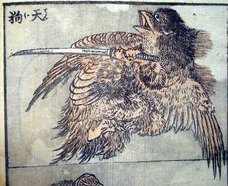
Fear of the Sword
by the Arrow Mountain Tengu
Many people practice with swords and think they are swordsmen. There are fancy forms and partner drills, choreographed applications, and even fights with padding and bamboo, but few of these practices really deal with fear. Fear and its effects can be easily seen in a sword wielder’s body, jerking their eyes about, pulling up their shoulders, knocking their blade out of position, pushing them back from their opponent, and sabotaging their technique. Fear blocks our counter-attacks, ruins our defenses, and neuters our attacks. In order to assuage our fear, we wear more armor when we train, we make our weapons conform to narrow standards, we ‘stick to our style’, we reduce free confrontation to rigidly choreographed partner drills or to contests bound by rules carefully calculated to give advantage to our favorite forms. By giving in to our fears in such fashions, we destroy the martial content of our training and deceive ourselves about what we are capable of doing with the sword.
Let’s step back a bit now. There are times in training to do all of these things, but they are means, not ends. Beginners who have not learned control must be able to safely continue training even in the face of potential accidents. Safe swords and padding are a place to start until one’s skills start to protect them. Beginners must use a ‘typical’ weapon until they learn the characteristics of the weapon they’re training with. Choreography serves to provide structure within which the student can explore the techniques being studied without distraction from unpredictable actions and reactions. All of these activities are designed to bring a student safely from the beginning of their training to the point in which they can begin to really start to learn the sword. However, in most traditions, the training never progresses beyond this point, and all the work hits an invisible ceiling that stunts further improvement. We can never progress past a certain point with this type of ‘safe’ training alone. We start to ignore dangerous holes in our guard because our padding or armor has never allowed us to feel the real consequences of our mistakes. We can become frozen in the face of attacks that aren’t part of our choreographed repertoire. Our mind, due to the hidden limitations in our training, can harbor false expectations about what the opponent can or will do, hindering our ability to respond properly.
In order to really begin to study the sword, we must be able to face unpredictable attacks from opponents that are really trying to hit us. We must develop the courage to stare at the unknown and wait to see what emerges. We must be able to operate at the speeds that the sword is actually capable of, and be able to deal with as much real danger as we can reasonably provide in a modern training environment. This danger is what fuels our practice, and our practice inevitably fails without it. Without danger, we don’t have true incentive to perform the necessary actions at the right time. Without some danger, we aren’t provided with accurate feedback regarding the effectiveness of our techniques and concepts. The sword is a binary system: you are either cut or you’re not. Proper practice that includes contact makes it harder to lie to yourself about what you’re learning.
Our training is one-sided without some risk. Our body teaches itself a great many things in the face of danger, and by providing that danger, our training grows evenly and robustly along many parallel tracks. There are ways to train more than just the technique we are concentrating on. By providing some perception of danger in our training, our body can learn without intercession from the mind. Much of our learning can become自然 ziran, or self arising (natural, spontaneous, self-so), with this content included in our training.
On the other hand, we must also allow the mind to participate in this process, as it is not truly separate from the body. We must also give and receive danger in how we think about our training. We must train as if life and death hung in the balance. When giving an attack to our training partners, we must provide them with a feeling of our intent. Our attacks, while given at the agreed upon speeds and power levels, must have our minds behind them, as if we were going to kill. Those who receive the techniques must operate as if they mean to kill in turn. While we abhor violence, without this killing focus foremost in our mind our training is empty and does not give our training partners good information from which to learn. They must feel the danger and learn to operate calmly within it.
Risk doesn’t have to mean full speed, full contact, live-blade sparring. It can be a gentle as actually touching the opponent, rather than ‘understanding’ that you ‘could have’ touched them. It means accurate targeting when performing and receiving techniques. It means developing our courage to stay engaged with an attacker, even when the attack is intimidating and dangerous. It means learning to lose, and investing in our losses so that we can truly improve. We must learn to let go of our attachments to success and failure. We need to let go of our fear by turning to face it and confronting its true purpose in our training.
by the Arrow Mountain Tengu
Many people practice with swords and think they are swordsmen. There are fancy forms and partner drills, choreographed applications, and even fights with padding and bamboo, but few of these practices really deal with fear. Fear and its effects can be easily seen in a sword wielder’s body, jerking their eyes about, pulling up their shoulders, knocking their blade out of position, pushing them back from their opponent, and sabotaging their technique. Fear blocks our counter-attacks, ruins our defenses, and neuters our attacks. In order to assuage our fear, we wear more armor when we train, we make our weapons conform to narrow standards, we ‘stick to our style’, we reduce free confrontation to rigidly choreographed partner drills or to contests bound by rules carefully calculated to give advantage to our favorite forms. By giving in to our fears in such fashions, we destroy the martial content of our training and deceive ourselves about what we are capable of doing with the sword.
Let’s step back a bit now. There are times in training to do all of these things, but they are means, not ends. Beginners who have not learned control must be able to safely continue training even in the face of potential accidents. Safe swords and padding are a place to start until one’s skills start to protect them. Beginners must use a ‘typical’ weapon until they learn the characteristics of the weapon they’re training with. Choreography serves to provide structure within which the student can explore the techniques being studied without distraction from unpredictable actions and reactions. All of these activities are designed to bring a student safely from the beginning of their training to the point in which they can begin to really start to learn the sword. However, in most traditions, the training never progresses beyond this point, and all the work hits an invisible ceiling that stunts further improvement. We can never progress past a certain point with this type of ‘safe’ training alone. We start to ignore dangerous holes in our guard because our padding or armor has never allowed us to feel the real consequences of our mistakes. We can become frozen in the face of attacks that aren’t part of our choreographed repertoire. Our mind, due to the hidden limitations in our training, can harbor false expectations about what the opponent can or will do, hindering our ability to respond properly.
In order to really begin to study the sword, we must be able to face unpredictable attacks from opponents that are really trying to hit us. We must develop the courage to stare at the unknown and wait to see what emerges. We must be able to operate at the speeds that the sword is actually capable of, and be able to deal with as much real danger as we can reasonably provide in a modern training environment. This danger is what fuels our practice, and our practice inevitably fails without it. Without danger, we don’t have true incentive to perform the necessary actions at the right time. Without some danger, we aren’t provided with accurate feedback regarding the effectiveness of our techniques and concepts. The sword is a binary system: you are either cut or you’re not. Proper practice that includes contact makes it harder to lie to yourself about what you’re learning.
Our training is one-sided without some risk. Our body teaches itself a great many things in the face of danger, and by providing that danger, our training grows evenly and robustly along many parallel tracks. There are ways to train more than just the technique we are concentrating on. By providing some perception of danger in our training, our body can learn without intercession from the mind. Much of our learning can become自然 ziran, or self arising (natural, spontaneous, self-so), with this content included in our training.
On the other hand, we must also allow the mind to participate in this process, as it is not truly separate from the body. We must also give and receive danger in how we think about our training. We must train as if life and death hung in the balance. When giving an attack to our training partners, we must provide them with a feeling of our intent. Our attacks, while given at the agreed upon speeds and power levels, must have our minds behind them, as if we were going to kill. Those who receive the techniques must operate as if they mean to kill in turn. While we abhor violence, without this killing focus foremost in our mind our training is empty and does not give our training partners good information from which to learn. They must feel the danger and learn to operate calmly within it.
Risk doesn’t have to mean full speed, full contact, live-blade sparring. It can be a gentle as actually touching the opponent, rather than ‘understanding’ that you ‘could have’ touched them. It means accurate targeting when performing and receiving techniques. It means developing our courage to stay engaged with an attacker, even when the attack is intimidating and dangerous. It means learning to lose, and investing in our losses so that we can truly improve. We must learn to let go of our attachments to success and failure. We need to let go of our fear by turning to face it and confronting its true purpose in our training.

 RSS Feed
RSS Feed

